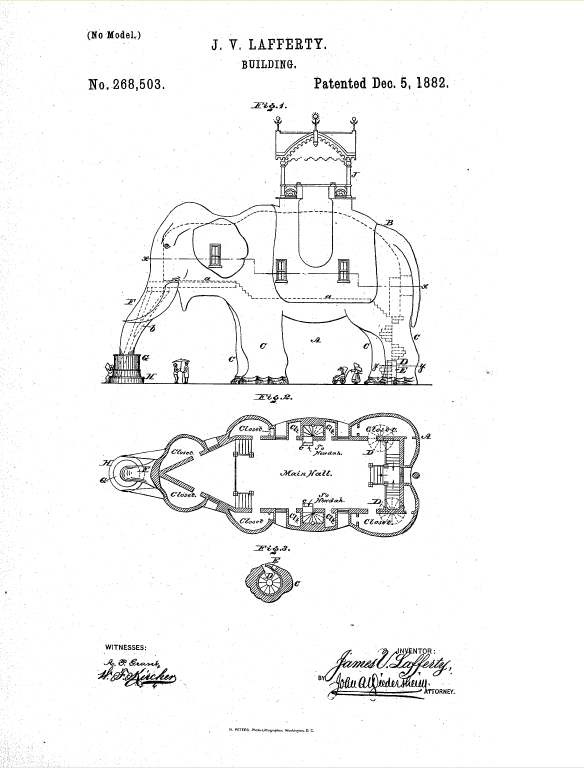Lucy the Elephant
| Line 20: | Line 20: | ||
Lucy has continued to attract tourists to the area. In 2020, Lucy became an Airbnb property (the only National Historic Landmark available through the hosting service) for a limited number of stays. Even when booked, Lucy is still open for tours. | Lucy has continued to attract tourists to the area. In 2020, Lucy became an Airbnb property (the only National Historic Landmark available through the hosting service) for a limited number of stays. Even when booked, Lucy is still open for tours. | ||
| + | |||
| + | --[[User:Heidi_Schwartz|Heidi Schwartz]] | ||
= Related articles on Designing Buildings Wiki = | = Related articles on Designing Buildings Wiki = | ||
Revision as of 09:33, 29 May 2020
Contents |
Introduction
Lucy the Elephant, originally named Elephant Bazaar, is a six storey building in the seaside town of Margate, New Jersey. The structure was built by James V. Lafferty, Jr in 1882 to attract economic development to the area.
Lafferty would invite real estate investors into Lucy’s uppermost carriage (or howdah) to enjoy the panoramic view of nearby Atlantic City and the Atlantic Ocean. He would also point out surrounding plots of land that could be purchased by potential investors.
Becoming Lucy
Philadelphia architects William Free and J. Mason Kirby were hired to design the structure based on Lafferty’s patented plans. The completed structure required roughly one million pieces of timber and was covered in 12,000 square feet of tin. It stands 19.7m high, 18.3m long and 5.5m wide and weighs approximately 90 tons.
The Elephant Bazaar was given the name ‘Lucy’ after it was sold in 1887 to Anton Gertzen of Philadelphia. Over the years, Lucy was used as a restaurant, office building, cottage and pub (which closed during Prohibition).
Lucy today
Time had taken its toll on Lucy, and in the 1960s, she was scheduled for demolition. A campaign to save her was successful, and she was refurbished and moved to a location a short distance from her original site. She was hit by a lightning strike in 2006 that discoloured her tusks.
Lucy has continued to attract tourists to the area. In 2020, Lucy became an Airbnb property (the only National Historic Landmark available through the hosting service) for a limited number of stays. Even when booked, Lucy is still open for tours.
Related articles on Designing Buildings Wiki
- American architecture and construction.
- Big Duck.
- Fish Building, India.
- Haines Shoe House.
- ING House.
- Piano Building.
- Teapot Dome Service Station.
- The Headington Shark.
- The Kelpies.
- The Oculus.
- Unusual building design of the week.
Featured articles and news
Infrastructure that connect the physical and digital domains.
Harnessing robotics and AI in challenging environments
The key to nuclear decommissioning and fusion engineering.
BSRIA announces Lisa Ashworth as new CEO
Tasked with furthering BSRIA’s impressive growth ambitions.
Public buildings get half a million energy efficiency boost
£557 million to switch to cleaner heating and save on energy.
CIOB launches pre-election manifesto
Outlining potential future policies for the next government.
Grenfell Tower Inquiry announcement
Phase 2 hearings come to a close and the final report due in September.
Progress from Parts L, F and O: A whitepaper, one year on.
A replicated study to understand the opinion of practitioners.
ECA announces new president 2024
Electrical engineer and business leader Stuart Smith.
A distinct type of countryside that should be celebrated.
Should Part O be extended to existing buildings?
EAC brands heatwave adaptation a missed opportunity.
Definition of Statutory in workplace and facilities management
Established by IWFM, BESA, CIBSE and BSRIA.
Tackling the transition from traditional heating systems
59% lack the necessary information and confidence to switch.
The general election and the construction industry
As PM, Rishi Sunak announces July 4 date for an election.
Eco apprenticeships continue help grow green workforce
A year after being recognised at the King's coronation.
Permitted development rights for agricultural buildings
The changes coming into effect as of May 21, 2024.






















